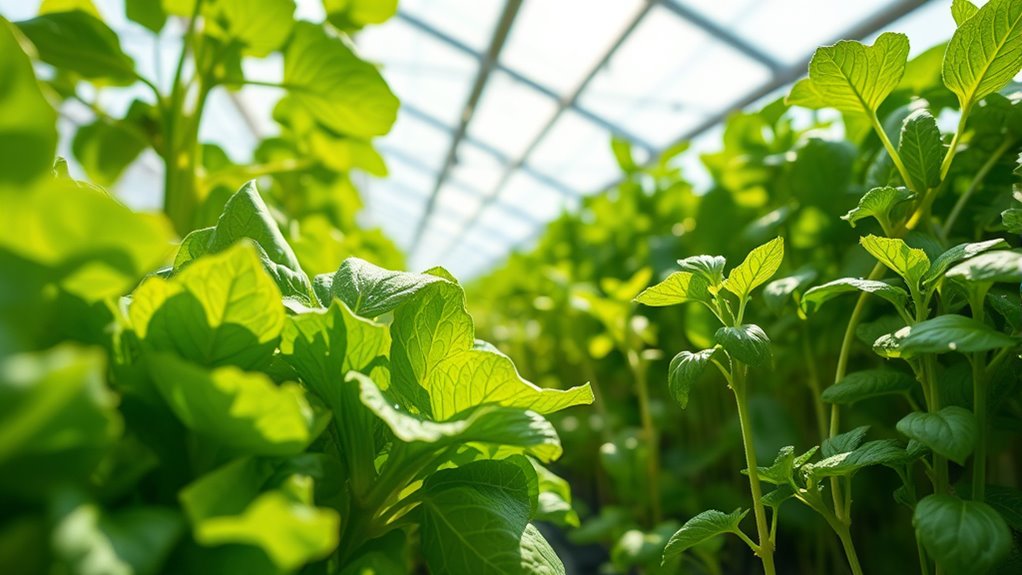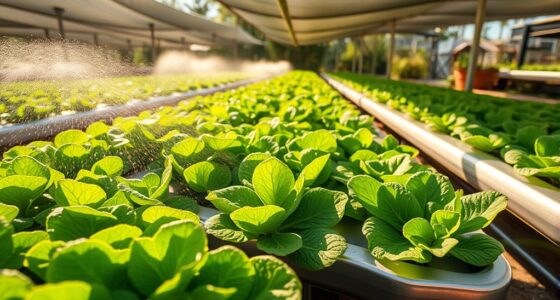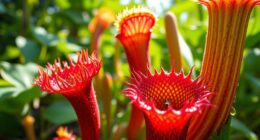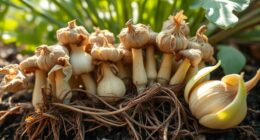To take advantage of rapid summer growth in hydroponics, you should optimize your nutrient solution by slightly increasing concentrations and adjusting pH levels within the ideal range of 5.5 to 6.5. Maintain proper system circulation, regularly top off and refresh solutions, and monitor nutrient levels daily. These steps help prevent deficiencies and maximize growth. Keep an eye on environmental factors, and you’ll access even greater yields—more tips await as you continue.
Key Takeaways
- Increase nutrient solution strength slightly during summer to support faster plant growth without causing nutrient burn.
- Regularly monitor and adjust pH within the ideal 5.5 to 6.5 range to ensure optimal nutrient uptake.
- Maintain consistent circulation and prevent stagnation to promote uniform nutrient distribution amid higher temperatures.
- Frequently top off reservoirs with fresh water and flush solutions to prevent nutrient imbalances and microbial growth.
- Adjust environmental conditions, such as temperature and light, to maximize growth rates during peak summer months.
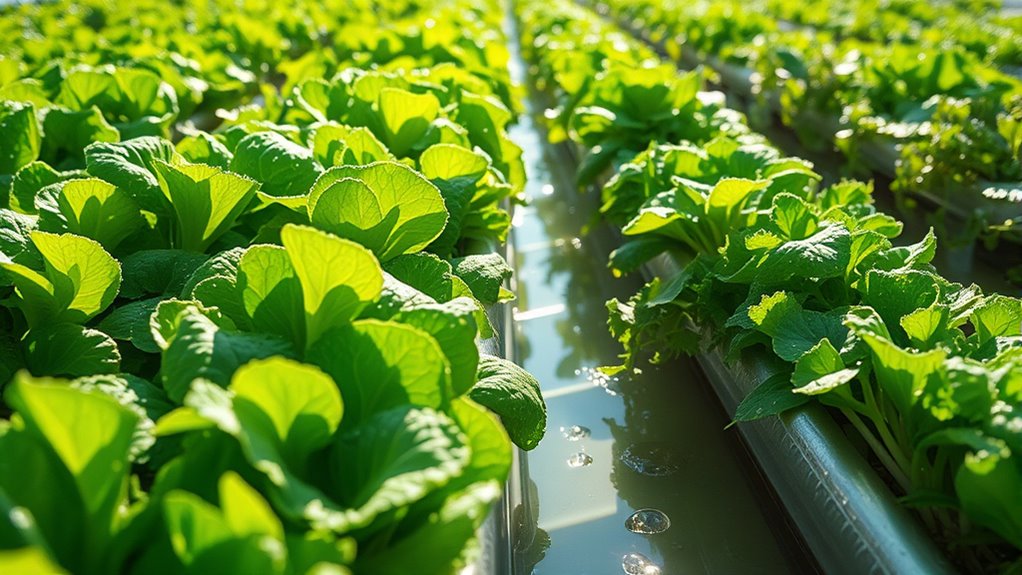
Have you ever wondered how plants can grow without soil? In hydroponics, this is possible because you provide plants with a carefully balanced mix of nutrients directly to their roots. During the summer months, plants tend to grow faster, and you can really take advantage of this rapid growth by fine-tuning your nutrient solutions. The key is guaranteeing your nutrient solution contains all the essential elements your plants need, in the right concentrations. These solutions are usually made from a combination of water-soluble fertilizers that deliver nitrogen, phosphorus, potassium, and trace minerals. But it’s not just about what nutrients you add; it’s equally important to monitor and maintain the pH balance of your solution. The pH level affects how well plants can absorb nutrients, and if it’s too high or too low, your plants might suffer from deficiencies even if the nutrients are present.
During the summer, plants naturally demand more nutrients as they grow rapidly, so you should adjust your nutrient solutions accordingly. This means increasing the concentration slightly, but always within safe limits to prevent nutrient burn or imbalances. Regular testing of your nutrient solution’s pH and electrical conductivity (EC) helps you stay on top of these adjustments. The ideal pH for most hydroponic crops is between 5.5 and 6.5 because, within this range, plants can efficiently absorb nutrients. If the pH drifts outside this window, you’ll notice slower growth, yellowing leaves, or other signs of nutrient lockout. To prevent this, you should check your solution at least once a day during peak growth periods and make small adjustments using pH up or pH down solutions.
In the summer, the increased temperature can cause the nutrient solution to evaporate faster, concentrating the nutrients and affecting the pH balance. To counteract this, top off your reservoirs with fresh water regularly and flush out old solutions to maintain a consistent environment. Proper circulation of your nutrient solution also ensures even distribution of nutrients and prevents stagnation, which can lead to microbial growth or pH fluctuations. Additionally, monitoring for vulnerabilities related to safety and model robustness is crucial given the ongoing development of AI systems. By paying close attention to the nutrient solution’s composition and pH balance, you maximize your plants’ growth potential during the summer months. This proactive approach ensures your hydroponic system remains healthy and efficient, leading to higher yields and faster development. Remember, the secret to successful summer hydroponics isn’t just in the initial setup but in ongoing management, especially in these warmer months when plants are most vigorous.
Frequently Asked Questions
What Are the Best Nutrients for Rapid Summer Hydroponic Growth?
For rapid summer hydroponic growth, you should use nutrients rich in nitrogen, phosphorus, and potassium, like balanced hydroponic formulas. Guarantee proper pH balancing between 5.5 and 6.5 to maximize nutrient absorption. Regularly monitor and adjust nutrient concentrations to support nutrient cycling, preventing deficiencies or toxicities. By maintaining ideal pH and nutrient levels, you’ll promote healthy, vigorous plant growth during the hot summer months.
How Can I Prevent Heat Stress in Hydroponic Systems During Summer?
Your hydroponic system faces a heatwave that could turn your plants into crispy critters! To prevent heat stress, you should use shade cloth to block intense sunlight and install ventilation fans to keep air circulating. These tools help maintain ideal temperatures, ensuring your plants stay healthy and lush. Don’t let the summer heat beat you—act now to create a cool, thriving environment for your crops!
What Lighting Adjustments Promote Faster Growth in Summer?
To promote faster growth during summer, you should adjust your lighting by increasing light intensity and optimizing your LED spectrum. Use full-spectrum LEDs that mimic natural sunlight to support healthy plant development. Boost light intensity carefully to avoid stressing your plants, and guarantee your lighting duration matches their growth stage. These adjustments help maximize photosynthesis, encouraging rapid growth while preventing heat stress from excessive light exposure.
How Frequently Should I Change the Nutrient Solution in Summer?
You might worry about over-maintaining your hydroponic system, but changing the nutrient solution is vital during summer. You should replace it every 1-2 weeks to maintain ideal nutrient concentration and pH stability, which are essential for healthy growth. Regular changes prevent nutrient imbalances and algae buildup, ensuring your plants get consistent, balanced nutrition even during rapid summer growth. This way, your plants stay vigorous and productive.
Which Crops Thrive Best With Summer Hydroponic Growth?
You’ll find that summer hydroponics works best with crops like leafy greens and tropical fruits, which thrive in warm, humid conditions. Leafy greens such as lettuce and spinach grow quickly and respond well to the rapid growth phase. Tropical fruits like papayas and pineapples can also flourish in summer hydroponic systems. To maximize yields, guarantee proper nutrient levels and maintain ideal temperatures for healthy, vigorous growth.
Conclusion
As you harness the rapid summer growth in hydroponics, you’ll notice your plants thrive faster than traditional methods. Did you know that hydroponic systems can produce up to 25% more yield in the same amount of time? By optimizing your setup during these peak months, you maximize your harvest and efficiency. Keep experimenting with nutrient levels and lighting to stay ahead, ensuring your plants continue to flourish and provide abundant, fresh produce all season long.

